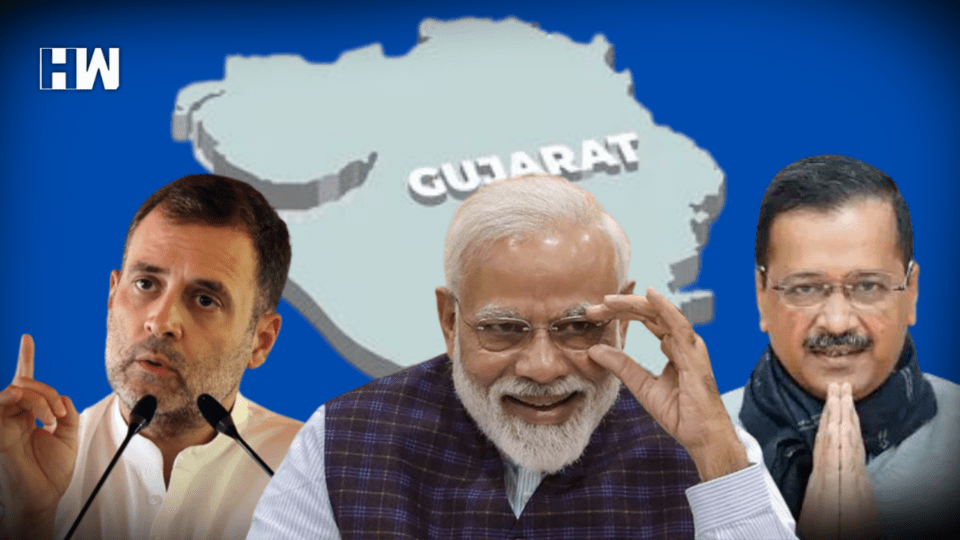Gandhinagar: Election Commission of India announces Gujarat Assembly Polls dates. Voting will be held in two phases on December 1 and 5. The counting of votes will be done on December 8. Chief election commissioner Rajiv Kumar told a press conference that the first phase of Gujarat Assembly elections will be held for 89 constituencies and the second phase for 93 constituencies. Voters will decide their electoral fate.
Date of issue of gazette notification: November 5 (Phase 1), November 10 (Phase 2)
Last date for nominations: November 14 (Phase 1), November 17 (Phase 2)
Date for scrutiny of nominations: November 15 (Phase 1); November 18 (Phase 2)
Last date for withdrawal of candidature: November 15 (Phase 1), November 18 (Phase 2)
Date of polls: December 1 (Phase 1), December 5 (Phase 2)
Date of counting: December 8 (Both phases)
There are in all 182 seats in Gujarat. There are 2,53,36,610 male voters, 23751738 female voters, 1417 third-gender voters, and 4,61,494 first-time voters. 4,90,89,765 are the total number of voters. The total number of polling stations is 51,782.
Out of 100% of voters, 88.57% of voters are Hindu, 9.67% are Muslim, 0.52% are Christan, 0.10% are Sikh, 0.96% are Jain, and 0.05% are Buddhist.
Also Read: ECI Announces Gujarat Elections Dates, Voting To Be Held In Two Phases
Just like this time assembly elections were held in two phases in 2017 and 2012 as well.
Last time BJP won the polls but the number of seats drop to its lowest tally since 1995. Last time they won 99 of 182 seats. The Congress had won 77 seats. Last time BJP had got 49.05% of the votes. Congress had got 41.44% of the votes. It was also the first election when the BJP fought without Narendra Modi at the helm.
Apart from Bharatiya Janata Party, Congress, and Aam Aadmi Party other major parties battling the elections are Gujarat Parivartan Party, Nationalist Congress Party, Bharatiya Tribal Party, and Gujarat Janata Party.
From 2017 to now there has been a major change in the battleground of Gujarat. AAP has entered the battlefield this year, which can give tough competition to Congress and BJP in the state. In 2017, apart from the big two, there was virtually no other party in the race, with Independents (3 of whom won) getting more votes than the NCP and BTP, which picked up 1 and 2 seats respectively.
While the BJP won fewer seats in 2017 than it did in 2012, it received more votes overall. The BJP received 115 seats and 47.85% of the vote in 2012 when Modi was still the chief minister. There were 61 seats and 38.93% of the vote in Congress.
This indicates that Gujarat made a huge jump the party would make five years later, largely on the strength of the Patidar quota agitation against the BJP government.
The two Lok Sabha elections that have been held since 2012 also demonstrate the BJP’s total control over the state. BJP won 63.1% of the vote and every seat in 2019 (the Congress received 32.6% of the vote), compared to 60.1% of the vote and 26 of the 26 seats in 2014 (the Congress received 33.5% of the vote).
OBCs are the most dominant voters here in Gujarat.
The OBCs make up almost 52% of the state’s population. In the Gujarat assembly, there are 50 seats designated for OBC, 32 for ST, and 20 for SC. Jagdish Thakor, the PCC president of the Congress, is an OBC leader, and Isudan Gadhavi is the joint general secretary of the AAP. The BJP has shifted its focus to the non-dominant groupings among them while still courting them both. There are 146 OBC Communities in Gujarat.
OBCs include the Vishvakarmas, who comprise artisans like carpenters, and blacksmiths; the Bhois, who traditionally pick water chestnuts and lotus stems and sell the same for livelihood; Ranas, who specialize in zari work on textiles; who rear camels or work as drummers; Odhs, who build mud houses and dig ponds; Goswamis, a community of sadhus; Vanzaras, a nomadic community; and Nai-Vanand, who are barbers. The Kolis are spread across the region, with predominant presence in Bhavnagar, Botad, Junagadh, Gir Somnath, Surendranagar and Rajkot districts. They are engaged in the agriculture, fishing and construction and building sectors. The Chaudhary community has a significant presence in Mehsana, Banaskantha, Sabarkantha and Gandhinagar districts. They are mostly engaged in farming and dairy farming and are the main milk suppliers in the region.
The Tribal Community holds considerable sway in the state.
Tribal Community constitutes nearly 15% of the population. 27 seats are reserved for ST in Gujarat. In Gujarat, there are 47 Assembly seats where the ST population is over 10%, nevertheless. Thirty-one Assembly seats have more than 30% ST population, while there are more than 20% ST in 40 Assembly seats.
Dalits form almost 7% of the population. They still continue to face discrimination, untouchability, oppression, and violence from employers and socially dominant groups.
As an independent media platform, we do not take advertisements from governments and corporate houses. It is you, our readers, who have supported us on our journey to do honest and unbiased journalism. Please contribute, so that we can continue to do the same in future.

